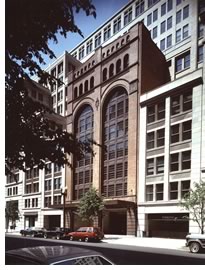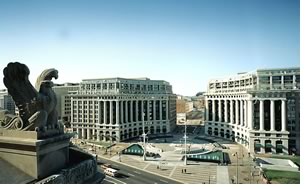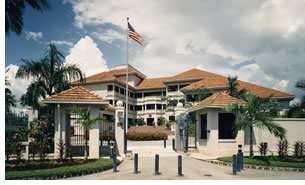

12/2005
by Tracy Ostroff
George E. Hartman Jr., FAIA, received The Centennial Award, AIA/DC’s highest service honor, at a dinner for the Washington Architectural Foundation October 21. The award is a tribute to Hartman’s distinguished record of public and professional service over four decades at the national and local level.
 Hartman earned both his BArch and MArch at Princeton University. In
1960 he joined the D.C. firm Keyes, Lethbridge & Condon, where he
met Warren Cox, who, in 1965, would become his business partner in the
firm that still bears their names. Hartman-Cox Architects, recipient
of the AIA Firm Award in 1988, has built a remarkable record of professional
achievement, with more than 100 design awards. In an August 1994 profile,
Washington Post architecture critic Benjamin Forgey wrote, “The
past 15 years or so of Washington architecture can be called, with little
exaggeration, the Hartman-Cox era.” In the years since, the firm
has continued to add to that legacy with projects such as the award-winning
Lincoln Square, the World War II Memorial, and the preservation and restoration
of the Lincoln and Jefferson Memorials.
Hartman earned both his BArch and MArch at Princeton University. In
1960 he joined the D.C. firm Keyes, Lethbridge & Condon, where he
met Warren Cox, who, in 1965, would become his business partner in the
firm that still bears their names. Hartman-Cox Architects, recipient
of the AIA Firm Award in 1988, has built a remarkable record of professional
achievement, with more than 100 design awards. In an August 1994 profile,
Washington Post architecture critic Benjamin Forgey wrote, “The
past 15 years or so of Washington architecture can be called, with little
exaggeration, the Hartman-Cox era.” In the years since, the firm
has continued to add to that legacy with projects such as the award-winning
Lincoln Square, the World War II Memorial, and the preservation and restoration
of the Lincoln and Jefferson Memorials.
Introducing Hartman at the awards dinner, Ray Rhinehart, Hon. AIA, the AIA national component’s senior director for special projects, said of his friend, “The genius of George Hartman the architect, and George Hartman the man has been and continues to be his uncanny ability to see us for what we ought to be and could be.” In the interview that follows, Hartman speaks about being a citizen architect, the importance of public service, and the built environment.
 Q. What are your first memories of awareness of the built environment?
Q. What are your first memories of awareness of the built environment?
A. I was a teenager in Japan. We lived in a Japanese house with tatami
mat floors; shoji screens; and paper, glass, and wood sliding shutters.
That was a very formidable experience in two ways. I remember having
a temper tantrum—my father was beating on me, and I picked up
a shoe and I threw it at him. He ducked, but it went through the wall.
My father didn’t say anything, but he made sure I was home the
next day when the Japanese workman came to repair it. He made new sticks
and covered them with paper, trimmed it, and finished it, and it was
an absolutely beautiful job. Nobody said anything, but I never broke
another shoji in my entire life. It’s like throwing a shoe into
a painting. The other was at the same house when the maid came in
and said, “It’s snowing outside, general.” And my
father said, “Open the screens.” They slid the doors open
and we were looking into the garden. We sat for an hour and a half
and watched the snow fall into the garden. Nobody said anything, and
it was absolutely beautiful.
Q. You are hailed as a “citizen-architect.” What
advice would you give others who want to be more engaged in their communities?
A. One of the best things to do that leads toward public policy is to
get involved with AIA committees that deal with Congress. In the process
of doing that, a great thing happened to me—dealing with the proposed
expansion of the West Front of the Capitol. You had to go up to the Hill
and talk with staffers, congressmen, and senators. And as you did that,
you learned how things really worked, what things mattered, what they
were interested in. What they want to do is do what they want to do,
and what you want to do is have things come out the way you want them.
By putting these together, you can make a deal—with the devil,
to a certain degree—and that’s just a wonderful experience.
Q. What does it mean to you and Warren Cox to have received the AIA
Firm Award?
A. The nice thing about that award is that it’s not for a given
building; it’s for 10 years of work or more. One of the things
that Warren and I had always taken very seriously in the ’60s was
to have a really good firm for 35 years. We elected to do that rather
than have the best firm in the country for two years. The Firm Award
is consistent with an attitude toward architecture that values place
and context as much as individual building design. If you asked me what
the legacy of my practice was, it would be to take a basically non-contributing
commercial office building and turn it into a positive piece of urbanism.
I think Hartman-Cox has had some success in the Washington area—Market
Square, for example.
 One of the things that is very depressing, which happened to us early
on, is that we were tearing down buildings and putting up buildings that
weren’t as good as the ones we tore down. So very quickly the work
got a lot better, and the buildings we were putting back up made as much
or more contribution, perhaps in a different way, as the ones we took
down. They enhanced the neighborhood. Your real client is the person
in the street walking around looking at buildings.
One of the things that is very depressing, which happened to us early
on, is that we were tearing down buildings and putting up buildings that
weren’t as good as the ones we tore down. So very quickly the work
got a lot better, and the buildings we were putting back up made as much
or more contribution, perhaps in a different way, as the ones we took
down. They enhanced the neighborhood. Your real client is the person
in the street walking around looking at buildings.
Q. Can you speak about your work as a member of several prominent review
commissions?
A. I am a great believer in the review process. I think review boards—and
I’ve served on a lot of them—serve a really good purpose.
There are great architects who have no use for them at all and think
they’re a negative influence. I think they are a positive influence:
Anything that causes you to slow down and talk about and explain what
you’re doing is good. And, too, the client goes to these meetings,
understands what’s happening, and sees what the review boards want.
So, slowly, the work gets a little better.
Q. You’ve served on federal architecture
review commissions and have built in the capital city and abroad. What
do you see as the future of federal architecture?
It does seem to me that there
are things that are more important in architecture than the individual
building. If you’re supposed to design a house, you look at the
block, and the neighborhood, and you see how things fit together. Then
you look at the city, town, and region. If you’re careful always
to work from the most important bigger things down to the smaller things
and find a good way for everything to be informed and hang together the
result is richer than it would ever be otherwise. If you see the individual
building as a piece of sculpture, then it’s hard for it to be more
than an object placed in an existing context. That’s much weaker
than it is to design an extension and enrichment of an existing fabric.
Things get enriched by responding to more and more things.
 For example, you tend not to put commercial buildings inward-looking.
Commercial always faces the street to give the street the light. It may
mean you have to design the interiors to make them interesting even without
their commercial content. At 1001 Pennsylvania Avenue, there’s
absolutely no commercial presence on the inside, and yet there are nice
passageways within that are 400 feet long, a whole city block. You have
to figure out ways to design these without the obvious shop-front boost
because if you put the shops on the inside, you’ve detracted from
the surroundings and you’re hurting something you’re trying
to help.
For example, you tend not to put commercial buildings inward-looking.
Commercial always faces the street to give the street the light. It may
mean you have to design the interiors to make them interesting even without
their commercial content. At 1001 Pennsylvania Avenue, there’s
absolutely no commercial presence on the inside, and yet there are nice
passageways within that are 400 feet long, a whole city block. You have
to figure out ways to design these without the obvious shop-front boost
because if you put the shops on the inside, you’ve detracted from
the surroundings and you’re hurting something you’re trying
to help.
Q. What is in the future of architecture and urban planning that gets
you most excited?
A. I think we’re going to live in towns. It’s no mistake
that our offices are in Georgetown. I live in Georgetown. I can walk
to work, and do. There’s a lot to be said for being an urban people.
In Rome, I was able to walk to everything. There are a lot places in
America where if you can walk around, they’re boring. You tend
not to find that in many older towns. One sign that you might look at
as the future are new developments that are built in the middle of nowhere.
We’re getting better at doing those. We’re going to find
that even though you’re in a fairly isolated place, you will develop
a town there just like they did in the old days. But now they will be
located plane rides apart, instead of stagecoach rides apart.
Copyright 2005 The American Institute of Architects.
All rights reserved. Home Page ![]()
![]()
 |
||
Among his many contributions to the profession, Hartman served as president of The Washington Chapter/AIA in 1976, overseeing the renovation of the Chapter House during his term. He chaired the national AIA Committee on Design and has served on numerous National Architectural Accreditation Board (NAAB) accreditation teams. Hartman has served as a College of Fellows juror and on more than 20 design awards juries. He served a four-year term on the U.S. Commission of Fine Arts from 1990–1994 and devoted nine years to the Architectural Advisory Board, Foreign Buildings Operations, U.S. Department of State. At various times in his 40-year career, he has served as an adjunct professor at the University of Maryland, the Catholic University of America, and North Carolina State University, in addition to lecturing frequently at other colleges and universities.
|
||